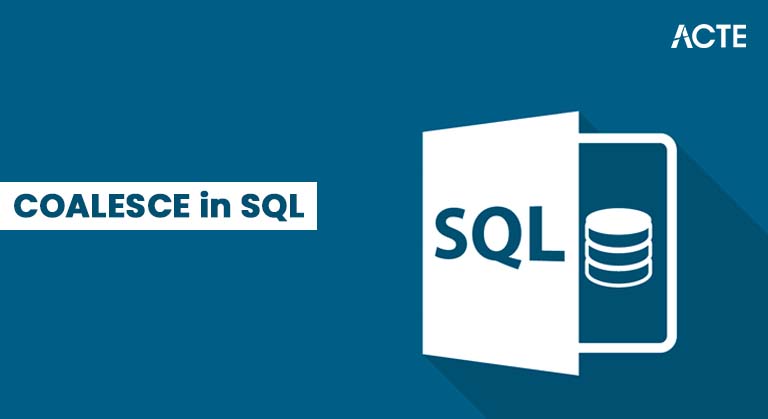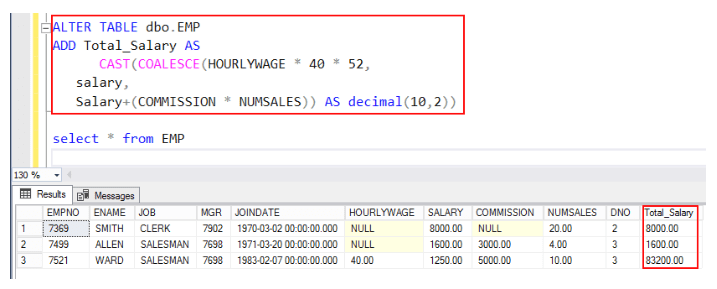
- Introduction to COALESCE
- Syntax and Functionality
- Use Cases for COALESCE
- COALESCE vs. ISNULL
- Handling NULL Values
- Using COALESCE with JOINs
- Nested COALESCE Examples
- Performance Considerations
Introduction to COALESCE
In SQL, efficiently handling NULL values is essential for ensuring accurate data retrieval, reporting, and processing. One of the most effective and commonly used functions for dealing with NULLs is the COALESCE function. The COALESCE function allows developers and analysts to return the first non-NULL value from a list of expressions, enabling them to replace missing or undefined data with default or fallback values. This functionality is particularly useful in situations where data may be incomplete or when merging data from multiple sources where fields may be inconsistently populated. By specifying a sequence of values, COALESCE evaluates each one from left to right and returns the first that is not NULL. If all expressions are NULL, it returns NULL. This makes it highly practical for enhancing data completeness in outputs such as reports, dashboards, or any kind of analytic summaries, a core focus in Database Developer Training. For instance, when displaying customer contact information, you might use COALESCE(phone_number, email_address, ‘No contact available’) to ensure that some form of contact information is always presented, even if certain fields are missing. Another benefit of COALESCE is its ability to simplify conditional logic. Instead of writing complex CASE statements to handle NULLs, a single COALESCE function can achieve the same result more succinctly. It also plays a vital role in calculations, ensuring that NULL values do not cause entire expressions to evaluate to NULL, which can otherwise lead to misleading or incomplete analytical outcomes. Overall, COALESCE is a powerful and essential tool in SQL that promotes data integrity, readability, and robustness in queries involving potential NULL values.
Interested in Obtaining Your Database Certificate? View The Database Online Training Offered By ACTE Right Now!
Syntax and Functionality
The syntax of the COALESCE function in SQL is both simple and powerful, making it an essential tool for handling NULL values in queries. The basic syntax is: COALESCE(expression1, expression2, …, expressionN). It requires at least two expressions but can accept many more. These expressions are evaluated in the order they are listed, from left to right. The function returns the first non-NULL value it encounters. If all the provided expressions evaluate to NULL, then COALESCE will return NULL, a concept useful when working with the MongoDB Commands Cheat Sheet. This sequential evaluation and early exit behavior makes COALESCE highly efficient, especially when working with datasets that may contain gaps or missing values. For instance, if you’re trying to retrieve a preferred method of contact from a list of fields such as home phone, mobile phone, and email, you could use COALESCE(home_phone, mobile_phone, email) to ensure a valid contact detail is returned, skipping over any NULLs. Once it encounters a non-NULL value, the function stops processing further expressions, which can also contribute to performance optimization in queries.

To illustrate this with a simple example, consider the following SQL statement: SELECT COALESCE(NULL, NULL, ‘Hello’, ‘World’) AS Result; This query evaluates each expression in sequence. The first two values are NULL, so it proceeds until it reaches the string ‘Hello’, which is not NULL. At that point, it returns ‘Hello’ and stops evaluating further. This behavior is what makes COALESCE particularly useful for setting fallback values and avoiding issues caused by missing data. It helps maintain data consistency and ensures that reports and outputs are as complete and meaningful as possible.
Use Cases for COALESCE
- Providing Default Values: COALESCE is often used to replace NULL values with a default, such as substituting zero for a NULL bonus in salary calculations to ensure accurate totals without errors.
- Data Cleaning and Merging Columns: When multiple columns may contain overlapping data with some NULLs, COALESCE returns the first non-NULL value, helping to consolidate and clean data from various sources into a single complete field.
- Simplifying Conditional Logic: Instead of complex CASE statements, COALESCE offers a straightforward way to handle conditions by returning the first non-NULL expression in a list, making queries easier to write and maintain, which is useful knowledge for DBMS vs RDBMS vs NoSQL.
- Improving Report Completeness: In reports, missing data can create gaps. Using COALESCE to provide fallback values ensures that reports display meaningful information rather than NULLs, enhancing clarity and usability.
- Handling Optional Relationships in Joins: When joining tables with optional or missing relationships, COALESCE fills in missing foreign key data, providing consistent output and avoiding confusion caused by NULLs in result sets.
- Preventing NULL in String Concatenation: NULL values in string concatenations often result in a NULL output. COALESCE replaces NULL strings with empty strings, allowing concatenated fields to display correctly without interruption.
- Priority-Based Data Retrieval: For cases with multiple possible data sources, COALESCE selects the highest-priority available value by evaluating expressions from left to right, useful in hierarchical or fallback data scenarios.
- Function Purpose: Both COALESCE and ISNULL handle NULL values in SQL, but COALESCE returns the first non-NULL value from multiple expressions, while ISNULL replaces a NULL in a single expression with a specified value.
- Number of Arguments: COALESCE accepts two or more arguments, checking each left to right to find the first non-NULL. ISNULL only takes two arguments: the expression to check and the replacement if it is NULL.
- Standard Compliance: COALESCE is part of the ANSI SQL standard, making it widely supported across different database systems, and commonly taught in Database Online Training.
- Data Type Precedence: COALESCE’s result data type follows the database’s standard data type precedence rules, which may cause implicit conversions. ISNULL returns the data type of the first argument, which can lead to different output types.
- Performance Differences: ISNULL can be slightly faster in some environments because it is simpler and proprietary. COALESCE is more flexible but may have minor overhead due to evaluating multiple expressions.
- Handling Multiple NULL Checks: COALESCE is more versatile since it can check multiple values in order until it finds a non-NULL one. ISNULL only handles one value and its replacement, limiting use in complex cases.
- Nullability and Result Behavior: The nullability of COALESCE’s result depends on its inputs, while ISNULL’s result usually inherits the nullability of the replacement value, which can affect how NULLs propagate in queries.
- NULLs in Joins: When performing LEFT JOINs or other outer joins, NULL values often appear in columns from the joined table if there is no matching row. This can cause issues in data display or calculations.
- Replacing NULLs: COALESCE is used to replace these NULLs with meaningful default or fallback values, ensuring that query results remain clear and useful instead of showing blank or NULL entries.
- Improving Readability: Using COALESCE in joint results improves report readability by avoiding NULLs that might confuse users or require additional explanation, an important consideration in Cassandra Vs MongoDB.
- Example Usage: For instance, when joining employees with departments, employees without an assigned department will have NULL in the department field. Applying COALESCE replaces NULL with a string like ‘No Department’ to indicate missing data explicitly.
- Preventing Errors: Replacing NULLs during joins also helps avoid errors or unexpected results in further processing, such as concatenations or conditional logic that do not handle NULLs gracefully.
- Consistent Output: COALESCE ensures consistent output formats in reports or applications by standardizing how missing related data is represented, which is important for user interfaces or exports.
- Flexible Defaults: The default value used with COALESCE can be customized as needed whether a placeholder text, zero, or any other appropriate value to fit the business logic or reporting needs.
To Earn Your Database Certification, Gain Insights From Leading Database Experts And Advance Your Career With ACTE’s Database Online Training Today!
COALESCE vs. ISNULL

Handling NULL Values
COALESCE is a fundamental tool in SQL for managing NULL values, which represent missing or undefined data. These NULLs can create challenges in data processing, especially in calculations and reports. If not handled properly, they can lead to unexpected results, such as broken arithmetic operations or incomplete information in query outputs. Using COALESCE ensures that queries return consistent and meaningful results by replacing NULLs with specified fallback values. One common scenario where COALESCE is particularly useful is in numeric calculations. For example, in a payroll system, employees might not always receive a bonus. If a bonus is missing and stored as NULL, trying to add it to an employee’s salary could result in a NULL total, which may distort compensation data, a scenario addressed when learning about Types of Joins in SQL Server. By using COALESCE, the missing bonus can be treated as zero, allowing the salary and bonus to be combined correctly. This approach ensures that total compensation is calculated accurately, even when some data is incomplete. Beyond calculations, COALESCE is equally helpful in data presentation. It allows reports and dashboards to display placeholder or default values instead of leaving fields blank when data is missing. For instance, when contact details or addresses are partially unavailable, COALESCE can help ensure something informative is always shown to the end user. Overall, COALESCE improves data reliability and presentation. It eliminates the risk of errors caused by NULLs and helps maintain data integrity in a wide range of SQL queries. Its simplicity and effectiveness make it an essential function for anyone working with databases.
Using COALESCE with JOINs
Nested COALESCE Examples
The COALESCE function in SQL is not only straightforward to use but also highly flexible, allowing it to be nested and combined with more complex expressions to handle a wide range of data scenarios. Nesting COALESCE means you can place one instance of the function inside another, enabling more layered and prioritized logic for handling missing values. This is particularly useful when working with deeply structured data or when fallback values themselves depend on additional conditions or other fields. For example, if multiple fields might contain the desired value, but each is only sometimes available, nesting COALESCE allows SQL queries to check them in a specific order and return the first one that contains valid data. In addition to nesting, COALESCE can be combined with other SQL functions to enhance its utility, especially when working with Schema in SQL Server. A common pattern is using COALESCE with NULLIF. The NULLIF function compares two values and returns NULL if they are equal. This can be useful in cases where a particular value, such as zero, should be treated as equivalent to missing. For instance, when evaluating salaries, a value of zero might not be meaningful. By applying NULLIF to treat zero as NULL, and then wrapping it with COALESCE, you can substitute a more descriptive message or alternate value whenever necessary. These advanced uses of COALESCE significantly improve data interpretation, especially in dynamic reporting environments. They offer fine-tuned control over how missing or default values are handled, making queries more intelligent, readable, and robust across various use cases.
Preparing for a Database Job Interview? Check Out Our Blog on Database Interview Questions and Answers
Performance Considerations
The COALESCE function in SQL is not only versatile but also generally efficient because it uses short-circuit evaluation. This means it checks each expression from left to right and stops as soon as it finds the first non-NULL value. As a result, unnecessary computation is avoided, which can help performance, especially when working with large datasets. However, to maintain clean and readable queries, it is important to use COALESCE thoughtfully. Using too many arguments or complex expressions within COALESCE can negatively impact readability. While it is possible to nest COALESCE functions, doing so unnecessarily can make the logic harder to follow and maintain. Simplifying expressions and avoiding excessive nesting helps ensure that your SQL code remains clear and efficient, a best practice emphasized in Database Online Training. From a performance perspective, it is also important to understand how COALESCE interacts with indexing. Although indexes on columns are not directly affected by the presence of COALESCE, queries that use it in the WHERE clause can become less index-friendly. This might reduce the effectiveness of indexes and lead to slower query performance in some cases. To ensure optimal performance, it is always best to test queries in your actual environment. The impact of COALESCE can vary depending on the database engine, the size of the data, and the structure of the indexes. By profiling queries and examining execution plans, you can make informed decisions about when and how to use COALESCE effectively.


